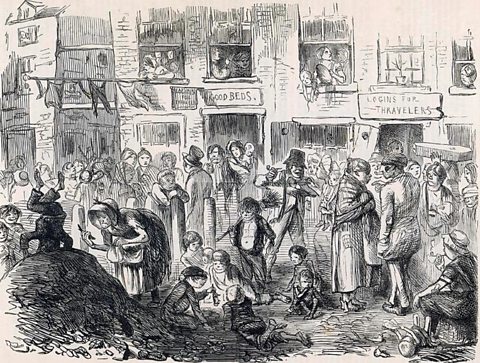Introduction to the plague
The world has suffered from many pandemicAn outbreak of infectious disease that occurs over a wide geographical area that affects a large number of people. - COVID 19 was not the first, nor will it be the last.
The Black Death is probably the most famous pandemic in history. Between 1347 and 1351, this outbreak of bubonic plague killed millions of people across Europe, North Africa and the Middle East.
Over the following centuries, plague returned many times, with a particularly deadly outbreak in the British Isles in 1665 and 1666.
 Image source, ALAMY
Image source, ALAMYVideo: The plague
How did a tiny bacteria lead to the deaths of millions of Europeans? In this video, learn about early pandemics and the impact of the plague.
Itтs 1645, and the plague that is ravaging Europe has arrived in Scotland. George Rae, a plague doctor, is standing Leith outside one of the isolation huts. He dreads the thought of what is waiting for him inside; more victims dying an incurable, horrible death т with little he can do to help.
As he watches the dead bodies being removed from the neighbouring huts, he takes a deep breath, comforted by the sweet smell of herbs from inside his beaked mask. For he believes it is bad air, called тmiasmaт, that has caused the plague to ravage the port of Leith once again.
But, although he didnтt know it, Georgeтs true protection was his leather cloak, which was stopping the fleas carrying the plague virus from biting and infecting him, as they had done with so many others.
The plague first emerged in Central Asia in the 1300s and spread like wildfire, before reaching Europe in 1347. Over the course of two and a half centuries, the plague is estimated to have wiped out half of Europeтs population and killed tens of millions of people across the globe.
Those infected initially developed a fever, aching and vomiting, before painful buboes would appear and, for around half, death would swiftly follow mere days later.
Scotland was no stranger to the plague, suffering multiple waves and thousands of deaths from the start of the Black Death until the mid-17th century.
The port of Leith was particularly vulnerable, as ships from plague infected areas overseas harboured rats that infected Leithтs unfortunate locals. The outbreak in 1645 proved the most devastating, leading to the demise of over half of the townтs population.
In the 1600s, understanding of what caused and spread the plague was limited. Some saw it as Godтs punishment on a sinful population and thought the best way to fight the disease was through prayer. Others blamed miasma т inhaling тpoisonousт or тbadт air from rotting food and waste that lined the streets.
To prevent the plague spreading in Scotland though miasma, тfoul clengersт were hired to dispose of the dead and cleanse the air.
But youтll be familiar with the most effective method т public gatherings were banned and plague victims were forced to isolate for forty days. In Italy, this was called тquaranta giorniт or quarantine, meaning forty days.
Measures like forced isolation and wearing protective clothing did actually help to prevent the plague from spreading even if not for the reasons they thought at the time.
Through the late 19th century, medical discoveries led people to realise that bacteria, and not bad air, was the cause of the disease, and the theory of miasma was replaced with Germ Theory.
The plagueтs origins were only discovered by researchers in 2022. Using DNA technology, they uncovered the plagueтs origins т uncovering skeletons buried in modern-day Kyrgyzstan that had been infected by the bacteria that caused and spread the plague.
See, the plague was actually caused by a bacterium called Yersinia pestis, spread by infected fleas and transported worldwide by rats.
And the plague itself? Well, it never actually went away. The last outbreak here in the UK was in 1980, and in China as recently as 2020.
What caused the plague?
At the time, it was not known how the plague spread - some people believed that farm animals were responsible for the disease and slaughtered their livestock.
Religious leaders believed that the plague was sent as a punishment by God for the sinful nature of the people.
Others, such as the doctors of the time, believed that the air had been poisoned and that when an individual breathed in this poisonous air they were infected with the plague. They called this bad air miasmaAn unpleasant smell. At the time of the Great Plague, many people believed that disease was caused by foul-smelling тvapoursт that were released by various different kinds of waste, including animal corpses and rotting food..
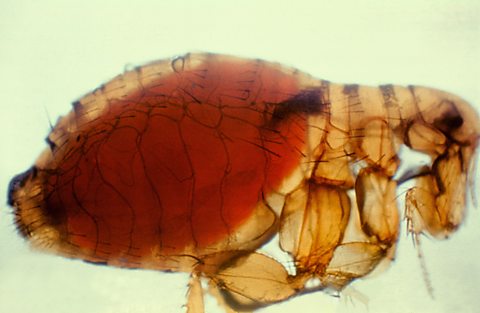 Image source, ALAMY
Image source, ALAMYModern research has found that the plague was caused by a bacteriumA tiny single-celled organism. The plural is bacteria. Bacteria exist in many forms, some of which cause diseases. known as Yersinia pestis.
This bacterium circulates amongst wild rodents, such as rats, and their fleas.
Yersinia pestis is spread when fleas drink the blood of infected rats. Once the infected rats die, the fleas move on to find a new host. An infected flea's bite passes the bacterium to their new host.
When the new host is a human, the bacteria enters humanтs bloodstream and the infection causes plague.
 Image source, ALAMY
Image source, ALAMYWhere did the plague come from?
 Image source, ALAMY
Image source, ALAMYIn 2022, researchers, including a team from the University of Stirling, tracked down the origins of the Black Death.
DNA samples taken from skeletons that had been buried in the north of modern-day Kyrgyzstan, Central Asia in the 1330s showed that they had been infected with the Yersinia pestis bacterium which causes plague. (Source: ).
Importantly, this region was criss-crossed by trading roads known as the Silk Route. These routes led from China all the way to the Mediterranean Sea.
From this small beginnings in a remote valley thousands of miles away, the Black Death would spread across Europe, eventually even arriving in Scotland.
 Image source, ALAMY
Image source, ALAMYHow did the plague spread?
Trade helped to spread the plague.
Travellers on the Silk Route took the infection with them. Often ships would carry the black rats, taking them (and their fleas) to new cities and countries.
- In 1346 the plague arrived in Europe and caused the deaths of millions of people.
- By 1348, it had arrived in southern and western England.
- In 1350, the plague arrived in Scotland т possibly as a result of a Scottish raid on England late in 1349.
Later outbreaks swept through Europe in the 1400s, and again in the 1600s
Symptoms of the plague
The infection was actually three diseases:
- Bubonic plague
- Pneumonic plague
- Septicemic plague
Bubonic plague
The most common form of plague is bubonic plague which affects the lymph nodesSmall glands located around the body that filter waste and infections from the body.. Two to eight days after infection, a person will develop fever, aches and vomiting.
Painful swellings called buboes would appear in sweaty regions of the body (armpit, groin and thigh). It is these buboes that give bubonic plague its name.
Around 50 per cent, or half or all those infected would die from bubonic plague.
Pneumonic plague
Pneumonic plague affects the lungs. Its main symptoms are fever, aches and coughing, including coughing blood.
It is caused by breathing in bacteria coughed out by an infected person, or spread to the lungs through a person's own blood supply.
Pneumonic plague was less common but killed nearly everyone who suffered from it.
Septicemic plague
Septicemic plague affects the blood. As well as aches and fever, this form of infection could cause bleeding and organ failure.
Blood supply to some parts of the body could stop. This could cause some parts of the body, such as the fingers, toes or nose, to die, rot and turn black.
This is one possible explanation for why the plague later became known as the Black Death.
Preventing the plague
Most people who became infected with plague died from it, so it was important to try and prevent it spreading. This was difficult because the cause of plague was not understood.
One method that did work was separating those who may have been infected from the rest of the population. This practice had been used from ancient times, featuring in the bible and writing from Ancient Greece.
In 1348, authorities in Venice in Italy brought in a rule that individuals or even whole ships coming from infected areas would have to wait for 40 days before coming into port. This was called quarantine. The word comes from the Italian quaranta giorni, which means forty days.
Quarantine is still used to this day, for example people infected with Covid-19 staying in isolation until they are free of infection.
Evidence produced at the time of the Great Plague of 1665-66 gives us useful information about what people did to try and prevent the plague from spreading. Some actions taken by the government included:
Instructing fires to be lit in the street, so people could breathe in the smell of smoke, rather than the miasma believed to be causing the disease.
Cats and dogs were killed, as it was believed that they might spread the plague. It is estimated that 40,000 cats and 200,000 dogs were killed.
Plague victims were locked in their houses for 40 days and a red cross was painted on their door. Watchers were employed to make sure people didnтt leave.
Searchers had the job of entering the home of suspected plague victims to search for bodies, and removing them to be placed in plague burial pits.
Public gatherings were banned, and people were not allowed to travel from one town to another unless they had a certificate proving they didnтt have plague.
Some people took action on an individual basis to try and protect themselves from catching the disease:
Some people, particularly searchers, who were responsible for collecting the bodies of plague victims, decided to smoke tobacco. It was believed this would protect them against plague, which was completely incorrect.
Some people placed money in small pots of vinegar when paying for goods to avoid touching it directly from someone else.
What was the role of women during the plague?
Many searchers were older women. They had to enter into the homes of plague victims to locate the dead bodies.
The work was poorly paid and dangerous, as it brought them into close contact with people infected by the plague.
During the seventeenth century, women were also responsible for a lot of medical care. They administered herbal remedies, which had been passed down through generations.
Medieval treatments for the plague
Various methods were used to try and cure an infected individual. Treatment depended on what people believed caused the plague.
Punishment from God
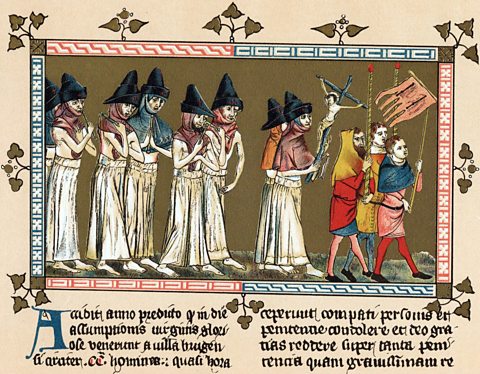 Image source, ALAMY
Image source, ALAMYThose who believed that the plague had been sent by God as a punishment turned to the Church for guidance and help.
The Church was ordered by King Edward III of England to hold a service every day so people could attend, pray for Godтs forgiveness and light candles as an offering to God.
In 1456, during another outbreak of plague, James II, King of Scots, passed a law that allowed priests to break the strict quarantineA place or period of time where people spend time on their own if they have come into contact with a disease that could be spread to others, to try and limit the spread of the disease. rules so that they could continue to conduct religious services to pray to God for deliverance from the plague.
Some people went without food for a time to show that they were sorry for their sins - this is known as fasting.
Many individuals went on journeys known as pilgrimages. They would journey to places of religious significance, such as the tombs of saints, and prayers would be offered to God.
Others, such as the flagellants, would harm themselves in public by whipping their own backs as a sign of how sorry they were for their sins.
 Image source, ALAMY
Image source, ALAMYBad air
 Image source, ALAMY
Image source, ALAMYThe quality of air was also blamed for the spread of plague - bad, stinking air known as miasma was thought to be a cause of the plague, especially in cities such as London.
In 1349, King Edward III of England issued a command to the Mayor of London, telling him to clean up the city streets by removing all waste. This included human bodily waste as well as animal dung - London had no sewers or sanitation system at the time.
- teams of muckrakers were set up to clear the streets of animal waste
- butchers were punished if they disposed of animal blood and remains in the street
- fines were introduced for any member of the public caught littering
In Scotland, people called foul clengers were paid to clear out the homes of people who had died from the plague and to dispose of the bodies.
Individuals also attempted to purify the air by carrying sweet smelling flowers or herbs whilst on their daily business, or by lighting fires in their homes to overpower the bad air.
 Image source, ALAMY
Image source, ALAMYWhy did plague doctors wear 'bird' masks?
Doctors during the 16th and 17th century wore elaborate outfits to protect them from the plague. They worked in the same way as the protective clothes and masks worn by modern doctors during the COVID-19 pandemic.
The plague doctors wore long leather or waxed cloth coats, and leather hats and gloves so that they had no bare skin exposed. This isolated them from their patients and the environment around them.
They also wore goggles made of glass and a mask with a long, bird-like beak. The beak was filled with herbs and sweet-smelling perfumes that they thought would keep them safe from breathing in the miasma (bad air) that the doctors wrongly believed was the cause of the plague.
Other plague treatments
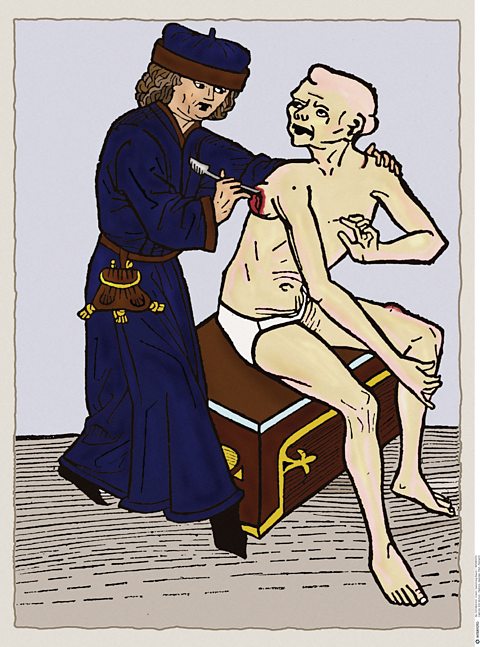 Image source, ALAMY
Image source, ALAMYThe plague had no cure and once a person had caught it, there was very little the doctors could do to treat them.
In desperation some treatments were tried:
- Buboes were burst to release the pus.
- Buboes were covered with bread and then the bread was buried.
- The infected individual took cold baths and avoided hot foods such as garlic and onions in an attempt to allow the body to rebalance itself.
None of the cures or treatments worked.
 Image source, ALAMY
Image source, ALAMYAftermath of the plague
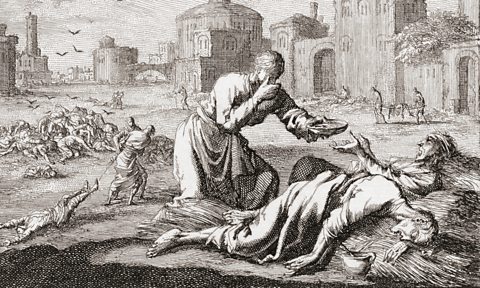 Image source, ALAMY
Image source, ALAMYWhile it is hard to get exact figures, it is estimated that around 25 million people in Europe were killed by the plague by 1350. That is almost a third of all people in Europe (source: ).
By 1350 the first wave of the plague was over. However, this was not the last time it would be seen in the British Isles. There were further outbreaks in the 1550s and 1640s.
In Scotland, they mostly affected the Central Belt and larger towns and cities on the east coast.
The last serious plague outbreak in the British isles was in 1665-6. London suffered particularly badly - up to 100, 000 people are thought to have died in the city. The spread of the disease began to drop after a very cold winter which may have killed off large numbers of rats. Many people argue that the Great Fire of London also played a part, destroying many rat-infested houses.
Fortunately, most of Scotland escaped the worst of this outbreak. The border with England was closed and trade and travel were banned with countries affected by the plague such as England and Holland. (Source: )
Leith, however, was not so fortunate. As a port with lots of boats arriving and departing it was at risk of infection. The 1665 plague killed over two thousand people - around half of the town's population.
Glasgow suffered an outbreak of plague as late as 1900 during the months of August and September. As a result of a late diagnosis of the 36 people who were infected, 16 people died.
 Image source, ALAMY
Image source, ALAMYImpact of the plague
The devastation caused to the population of Europe brought about a series of social and economic changes.
Social and economic
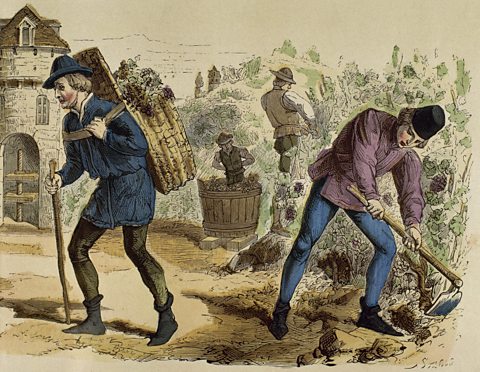 Image source, ALAMY
Image source, ALAMYAs many of the peasantry (the poor people) had died, those who remained were able to argue for better pay, jobs, and lower rent as there was a shortage in workers.
They were also able to improve their diets as they could now access better food due to there being less demand for food and because they could afford better quality.
Landlords found that their fortunes declined as they were unable to justify charging their tenants higher rents which reduced the amount of money they made.
The fortunes of women after the Black Death were mixed.
Some were able to gain a bit more independence as more men died from the plague than women. However this fact also meant that many women suffered as the main provider for the family had passed away and they were unable to work themselves.
 Image source, ALAMY
Image source, ALAMYThe impact on religion
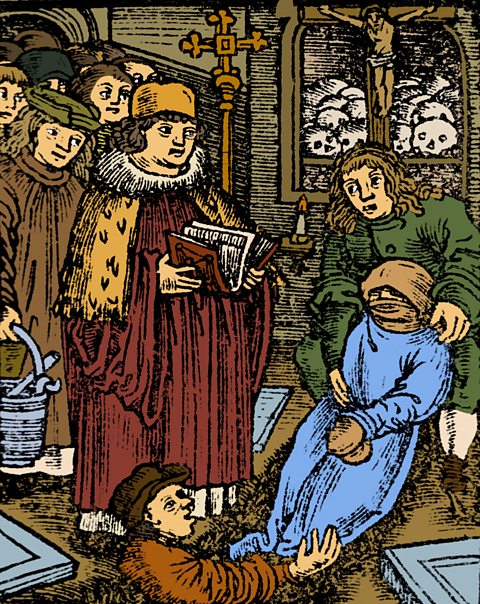 Image source, ALAMY
Image source, ALAMYThe plague posed significant problems for the Christian Church.
In the Middle Ages, the Church was at the heart of everyday life. People believed in God and the Devil and believed that the Church was there to guide and defend them.
During plague years - and for years after - the Church struggled to fulfil this role.
So many people were dying that the Church did not have enough priests to hold religious services and conduct marriages, Christenings, and burials.
The common view, as supported by the Church, was that the plague was sent by God to punish the wicked.
Since the plague did not discriminate and priests were just as likely to die as the peasants they ministered to, the Church was open to accusations that it itself was wicked.
For the first time, the Church's role was being questioned.
 Image source, ALAMY
Image source, ALAMYImpact on medicine
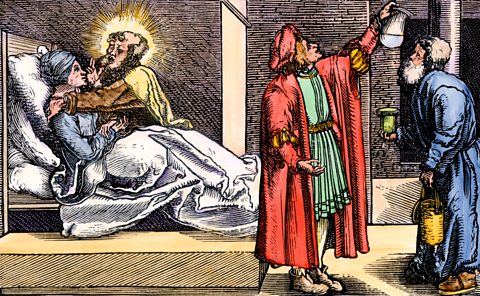 Image source, ALAMY
Image source, ALAMYIt is easy to find fault with the medical responses to the plague at the time as, today, some of the ideas they had about the infection seem ridiculous.
The doctors of the time were wrong about almost everything:
- The plague was not caused by miasma or bad smells.
- It was not a punishment for committing sins.
- Prayer was not a cure.
- Lucky charms and superstition were not effective treatments.
However, medical knowledge at the time was very limited and doctors had no knowledge of germs or bacteria.
The medieval response to plague did lead to some benefits and advancements, though:
- There was greater emphasis on public health.
- Streets and public places were cleared of human and animal sewage.
- Quarantine policies were commonly adopted to separate the ill from the healthy.
 Image source, ALAMY
Image source, ALAMYDoes the plague still exist
Plague still exists in many parts of the world.
In recent years there have been outbreaks in China, the Democratic Republic of Congo and Madagascar. However outbreaks have been small.
Even if plague were to spread, as we now understand that it is caused by a bacterium, it can be treated very successfully with antibiotics.
Test your knowledge
More on Medicine through time
Find out more by working through a topic
- count2 of 8
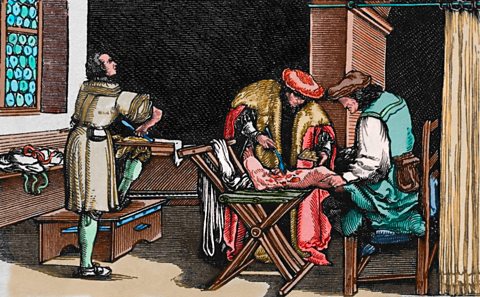
- count4 of 8

- count5 of 8
